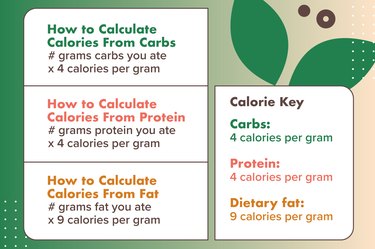
There are three macronutrients: carbohydrates, protein and fat. If someone is tracking their "macros," they're referring to these nutrients.
These macros fit into a balanced diet. Eating a wide variety and enough of these helps you meet your nutritional targets for micronutrients like vitamins and minerals. You naturally eat foods that contain these nutrients in your meals, but you may want to know how much of each.
Video of the Day
Video of the Day
Some people aim for specific targets for their macronutrients and choose to track them or count them similar to counting calories. This can help with weight loss, muscle gain and other fitness or nutritional goals. It's also generally helpful to see the breakdown of nutrients in the foods you're eating.
Counting calories and logging macros can be challenging. So here's how to calculate the percentage of your calories that come from carbs, protein and fat.
What Are Macronutrients?
Macronutrients are the nutrients your body needs the most in order to function: Carbs, proteins and fats. Because the body can't make enough of them on its own, it's essential that you get them from your diet, per August 2020 research in Nutrients.
Carbohydrates are sugar molecules. The body breaks down carbs as the main source of energy for your cells, tissues and organs, per the National Library of Medicine (NLM).
Protein is found in muscle, bone, skin, hair and almost every other part of the body. It's used for many chemical reactions that keep you alive and it helps carry oxygen to your blood, according to the Harvard T.H. Chan School of Public Health.
Fats provide your body with essential fatty acids, which are used for brain development, controlling inflammation, regulating body temperature and blood clotting. Fats also help keep your skin and hair healthy. They also help you absorb vitamins, according to the NLM.
Calculating Macro Percentages
Counting your macros may seem daunting at first, but after a while, it gets easier to tell which foods you should eat more (or less) of based on your nutritional goals. Here's how to do it.
Determine Your Nutritional Needs
Calculating your macronutrients is usually done to meet a specific goal.
If you're not sure what targets to aim for, the 2020-2025 Dietary Guidelines for Americans has a recommended dietary allowance for each of the three macronutrients:
- Carbs: 45-65% of daily calories
- Protein: 10-35% of daily calories
- Fat: 20-35% of daily calories
Calculate Your Total Intake of Calories
The first step to calculating any of the three macronutrients is to figure out the total amount of calories you ate and drank in a single day. You can do this by logging your food in a food diary or using an online calorie and nutrient counter.
Track Each Macronutrient Individually
Use a journal or online calorie counter to tally up your intake of each individual macronutrient. Count the number of carbohydrates, fat and protein you ate in grams. You should have three numbers in grams.
Determine How Many Calories Come From Each Macronutrient
Each macronutrient contains a different amount of calories, according to the USDA:
- Carbohydrates: 4 calories per gram
- Fat: 9 calories per gram
- Protein: 4 calories per gram
You can use these figures to calculate the number of calories you took in from each macronutrient.
Here are some examples:
- 65 grams of protein x 4 calories per gram = 260 total calories from protein
- 200 grams of carbohydrates x 4 calories per gram = 800 total calories from carbohydrates
- 60 grams of fat x 9 calories per gram = 540 total calories from fat
Divide Individual Macro Calories by Total Daily Calories
In the example above, the daily calories add up to 1,600. Take the number of calories from each macronutrient and divide it by the total amount of calories to get the percentages.
Here is what that calculation would look like using the example above:
- Protein: 260 calories from protein ÷ 1,600 daily calories = 16.25 percent of calories from protein
- Carbs: 800 calories from carbs ÷ 1,600 daily calories = 50 percent of calories from carbohydrates
- Fat: 540 calories from fat ÷ 1,600 daily calories = 33.75 percent of calories from fat

How to Calculate Percentage of Calories From Carbohydrates
To calculate the percentage of calories from carbohydrates, you'll need to know how many grams of carbohydrates you had in a day.
For example, one sweet potato contains 26 grams of carbohydrates, per the USDA. Do this for every food you eat.
Once you have the number of grams of carbohydrates you took in, you can multiply it by 4 as there are 4 calories in every gram of carbs. If you had 200 grams of carbohydrates in a day, that would equate to 800 of your daily calories from carbohydrates.
You can then calculate the percentage of calories that came from carbs. Take the number of calories that came from carbohydrates and divide it by the total amount of calories you had in a day. Then multiply that number by 100 to get the percentage.
For a 1,600-calorie diet, divide 800 by 1,600 to determine the percentage of calories that come from carbs. In this example, 50 percent of calories come from carbohydrates.
Cheat Sheet
- Multiply the # of grams of carbs you ate in a day by 4
- Then, take that # and divide it by your total calories for the day
- Multiply the number from step 2 by 100 to get the percentage
How to Calculate Percentage of Calories From Protein
To calculate your daily calorie percentage from protein, start by adding up the number of grams of protein you had in a day.
You'll need to track every food you eat. For example, 1 cup of black beans contains 15 grams of protein, according to the USDA. Do this for all the foods you ate that day.
Once you have the total amount of grams of protein you had, you can multiply it by 4 (because every gram of protein contains 4 calories). If you had 65 grams of protein in a day, that would add up to 260 calories from protein.
Take this number and divide it by the number of total calories you had in a day to get the percentage of calories that came from protein. For a 1,600-calorie diet, divide 260 by 1,600. Then, multiply it by 100 to get the percentage. This would equate to 16.25 percent of calories coming from protein.
Cheat Sheet
- Multiply the # of grams of protein you ate in a day by 4
- Then, take that # and divide it by your total calories for the day
- Multiply the number from step 2 by 100 to get the percentage
How to Calculate Percentage of Calories From Fat
Log your daily intake of food and add up the number of grams of fat you had in a day.
For example, half an avocado contains 15 grams of fat, according to the USDA. You'll need to do this for every food you ate that day from breakfast to dinner.
Once you've calculated the number of grams of fat you ate, multiply that figure by 9 (as there are 9 calories in every gram of fat). If you had 60 grams of fat, that would mean 540 of your calorie intake came from fat.
You can then take this number of calories coming from fat and divide it by the total number of calories had in a day. For a 1,600-calorie diet, divide 540 by 1,600. Then, multiply it by 100 to get the percentage. This gives you 33.75 percent of calories coming from fat.
Cheat Sheet
- Multiply the # of grams of fat you ate in a day by 9
- Then, take that # and divide it by your total calories for the day
- Multiply the number from step 2 by 100 to get the percentage
What Is the 4-9-4 Rule?
The 4-9-4 rule is a simple way to calculate the number of calories you'll get from each macronutrient in a food. To use the 4-9-4 rule, check your nutrition label and follow these formulas:
- Find "Total Carbohydrates" and multiply the amount by 4. This will give you the number of calories in the food that comes from carbs.
- Find "Total Fat" and multiply the amount by 9. This will give you the number of calories in the food that comes from fat.
- Find "Protein" and multiply the amount by 4. This will give you the number of calories in the food that comes from protein.
If you add all three of these amounts, you should get the total number of calories in the food.
- U.S. Department of Agriculture: "2020 - 2025 Dietary Guidelines for Americans"
- MyFoodData: “Nutrition Facts for Sweet Potatoes”
- USDA: “How many calories are in one gram of fat, carbohydrate, or protein?”
- USDA: “Nutrition Facts for Black Beans”
- USDA: “Nutrition Facts for Avocados”
- Nutrients: Macronutrients and Human Health for the 21st Century
- harvard T.H. Chan School of Public Health: Protein
- National Library of Medicine: Dietary Fats
- National Library of Medicine: Carbohydrates


